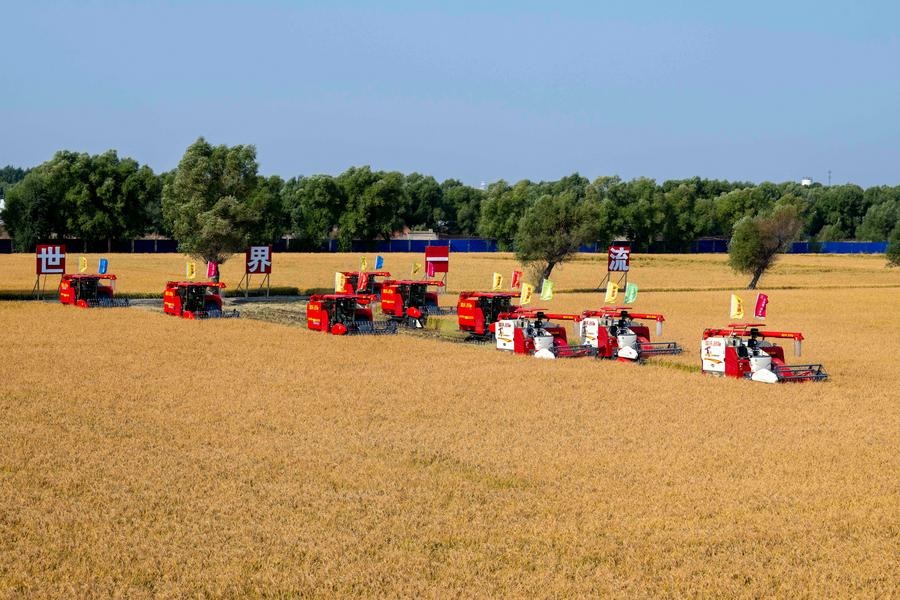Farmers return to their roots to reap abundant profits
Specialty agricultural products consolidate benefits from poverty-alleviation program


Zhaotong, a city in Southwest China's Yunnan province, is home to Yiliang, one of the 832 counties lifted out of the doldrums by China's poverty alleviation drive.
Since then, Zhaotong has capitalized on its special agricultural products to further push economic growth and improve rural living standards.
The city ranks first in Yunnan in the cultivation of apples, bamboo, gastrodia elata, Sichuan peppers and potato seed tubers. Last year, its total agricultural output value exceeded 150 billion yuan ($21.06 billion), and this year it is expected to reach 180 billion, local officials said.
Gastrodia elata, an orchid-like plant used in traditional Chinese medicine, has blossomed into a pillar industry of the county and reshaped its economy.
In Yiliang's Baozang village, farmer Jiang Qingkun has benefited from the transformation. In the past, Jiang was forced to seek work away from home due to low agricultural returns. But he literally returned to his roots when the gastrodia industry began to flourish.

"We used to get about 7.5 (metric) tons per hectare, but now it's 26.2 tons, which can earn over 100,000 yuan," Jiang said, adding that the family's annual income now exceeds 1 million yuan.
Before 2020, local farmers relied on self-cultivated fungi for planting gastrodia, resulting in low yields and carrying high risks. To overcome these challenges, Zhaotong established a comprehensive germplasm resource base for gastrodia, collaborating with research institutions to develop high-yield and stable varieties such as Zhaowuma No 1.
The city also attracted investment to establish standardized production facilities for the fungi needed to grow gastrodia, significantly boosting production capacity.
Yunnan Senhao Fungi, a key player in the sector, has seen annual production reach 1.9 million bags, with sales extending nationwide.
Long Tonghong, production manager at the company, said the Wutianma fungus strain they developed jointly with research institutes, can increase a farmer's income by more than 60,000 yuan per hectare. Gastrodia has been officially included in the national "medicine and food homology" catalog. The fresh gastrodia output of the city has reached 58,200 tons and the industry's comprehensive output value stood at 9.39 billion yuan by the end of 2024.
Specialty agricultural products have played a crucial role over the past five years in consolidating the victory over poverty alleviation and ensuring the rise of rural incomes, according to officials and experts.
China made remarkable strides in rural vitalization during the 14th Five-Year Plan period (2021-25), particularly in improving the livelihoods of once impoverished rural people.
Since then, each of the 832 counties lifted out of poverty has developed two to three leading industries, with the total output value exceeding 1.7 trillion yuan, according to the Ministry of Agriculture and Rural Affairs.
Rural incomes have continued to rise over the past five years, with the average disposable income of rural residents reaching 23,119 yuan in 2024. The income gap between urban and rural residents is narrowing, with the ratio decreasing from 2.56 yuan to 1 yuan in 2020, to 2.34 to 1 in 2024, Minister of Agriculture and Rural Affairs Han Jun said.
The agricultural sector has seen significant growth. The revenue of large-scale agricultural processing enterprises reached 18 trillion yuan last year. New industries and business models such as rural e-commerce and tourism are thriving, Han added.
Resettlement communities
Maojiawan in Ludian county is the largest resettlement community for poverty alleviation in China. Jobs are available at a "green" food park just half a kilometer away, an edible fungi base 1 km away, a scallion production base about 2 km away, and an apple orchard 3 km away.
Zhang Shaofen, a formerly impoverished farmer now living in Tao yuan community, said that in her spare time, she works at the scallion base where she earns 3,000 to 4,000 yuan a month.
"The scallion base is a major employer," said manager Xu Jianhua. "From mulching and planting, to harvesting and transport, every hectare of land requires 150 laborers," he said.
Last year, the area's core industrial bases provided 200,000 work opportunities for local farmers and relocated residents.
These industries take into account local resources, market prospects, and labor absorption capacity, and have strong momentum for growth. Among them, edible fungi have emerged as a key sector serving poverty alleviation.
Yunnan Yunmeng Biotechnology brought in technical teams from Shaanxi and Sichuan provinces to provide hands-on guidance, and partnered with research institutes including the Kunming Edible Fungi Research Institute of the All China Federation of Supply and Marketing Cooperatives and the Guangdong Academy of Sciences. The collaboration boosted the output of mushroom cultivation sticks.
"Now we've basically reached the break-even point, and we expect to turn a steady profit starting next year," said Li Xiaoyang, deputy general manager of the company.
To sharpen its competitive edge, the company is developing sales of graded dried mushrooms, and exploring new varieties such as artificially cultivated lurid bolete, or jianshouqing mushrooms.
National strategy
Zhaotong's efforts reflect a broader national strategy to consolidate poverty alleviation achievements and promote rural vitalization. Minister Han highlighted the importance of the five-year transition period that followed the 2020 victory over poverty. Its aim was to solidify and expand poverty alleviation results, and ensure a seamless transition to rural vitalization, he said at a news conference last month.
Approaches during the transition period have continued support for impoverished rural residents, enhancing their economic vitality and resilience.
During this period, efforts have been made to prevent large-scale returns to poverty. A robust monitoring and assistance system was established, providing targeted support to over 600 million people. This proactive approach helped ensure early intervention and support for those at risk, effectively reducing the chances of poverty relapse, Han said.
Efforts have also focused on improving people's motivation by combining developmental assistance with bottom-line guarantees, and emphasizing the importance of self-driven growth. Over 85 percent of formerly impoverished households have benefited from industry support, and employment initiatives have kept over 30 million people in stable jobs.
The transition period identified 160 key counties for rural vitalization, with significant resources directed to these areas. The central government has allocated over 850 billion yuan to support rural infrastructure and public services, leading to improved transportation, telecommunications, education, healthcare, and cultural facilities.
"China's poverty alleviation success has not only improved domestic conditions but also garnered international recognition, contributing Chinese solutions and wisdom to global poverty reduction efforts," Han said.
Maierdan Mugaiti, a vice-minister of agriculture and rural affairs, said the construction of livable and workable rural areas has seen significant progress.
Local authorities have tailored development strategies to boost rural industries and living conditions. The national average toilet coverage rate has reached 76 percent, and over 90 percent of administrative villages now manage waste effectively.
Rural infrastructure has also been significantly upgraded. The total length of rural roads now exceeds 4.64 million km, with 5G coverage reaching over 90 percent of administrative villages.
"As the delivery network now extends deeper into rural areas, more farmers can now send and receive parcels right at their doorstep," Maierdan said.
In addition, initiatives like the county-level medical system have made healthcare more accessible, with over 95 percent of village clinics covered by medical insurance. More than 140,000 elderly care facilities and over 16,000 rural nursing homes have been built, enabling senior citizens to enjoy a wider range of elderly care services, he added.
zhaoyimeng@chinadaily.com.cn
- China launches new magnetic resonance platform to support BCI technology
- HKSAR's 7th LegCo surpasses predecessor with 49 extra bills pass
- Xinjiang's snowy landscapes a hit with visitors
- China's State Council appoints, removes officials
- CityFly takes off as China's newest travel trend in low-altitude tourism
- Top court cracks down on firearms





































